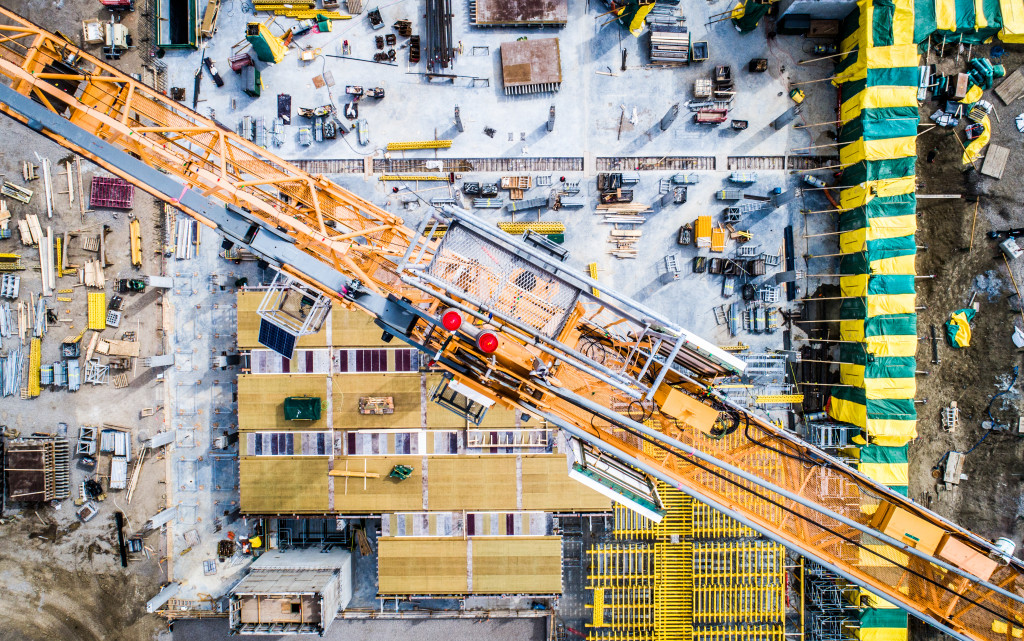
- Use the right equipment for safe lifting, such as cranes, pulleys, chains, and slings.
- Wear appropriate safety gear, including helmets, eye protection, protective clothing, and harnesses, to meet safety standards.
- Assess the weight of the load to determine how much is needed for transports and which equipment should be used.
- Use proper grip and lifting techniques to ensure a secure lift and prevent injuries.
Working on a construction site comes with its own set of risks, particularly when it comes to lifting heavy loads. Workers need to be aware of the safety precautions that should be taken when handling heavy objects. Before attempting to lift a heavy load on any construction site, here are some key things to consider. With these considerations in mind, workers can ensure their safety and that of their coworkers while working at height or with large items.
Use the right equipment.

Using the right equipment can help prevent accidents and damage to the goods being lifted. Some equipment important for safe lifting includes properly sized cranes, pulleys and chains, hoists, and durable webbing slings to secure the load for transportation.
Synthetic webbing slings are particularly useful in scenarios where a load’s atypical size or irregular shape prohibits a flat lifting surface. They are strong and hardy, making them ideal for this purpose. For maximum safety benefits, operators should ensure their equipment is regularly maintained and calibrated to avoid any costly accidents or malfunctions in the future.
Practice safety protocols.
Safety protocols are essential for any construction site, particularly with heavy lifting. Here are some tips on how to do it properly:
Assess the weight of the load.
Assessing the load’s weight involves weighing it with a calibrated scale before loading and securing it for transportation. Knowing how much weight is needed for transport can help reduce potential hazards by avoiding overloading carriers and minimizing driver fatigue and potential asset damage caused by adhering to a lesser capacity than necessary.
Proper assessment of the load’s weight also helps decide which type of equipment should be used when moving material. As such, proper assessment of loads is mandatory in construction sites to ensure safety and efficiency and minimize liabilities in any transportation situation.
Wear appropriate safety gear.

Safety gear should include helmets, eye protection, protective footwear, protective clothing, and harnesses that meet recognized standards. It is important to remember to adjust straps correctly when putting on a harness and test it for security before starting any work at height. Additionally, clear work instructions must be given before the lift commences to ensure correct lifting techniques are utilized, which will help avoid potential accidents.
Depending on the load size and shape, extra caution and supervisor approval must be taken before lifting begins. Even though an object may look manageable, its strength and stability can be unpredictable when under strain. Overall, wearing proper safety equipment minimizes the risk posed by heavy objects while working in a construction or demolition site and considers safety protocols to ensure workers remain protected.
Have a plan for lifting and carrying the object.
Having a detailed plan helps ensure the proper use of techniques and the right identification of hazardous materials. It also allows workers to assess any risk factors that could be present properly. Knowing the weight being lifted and understanding body mechanics are necessary for creating a well-thought-out plan.
With these details clarified, it allows workers to adopt correct postures while lifting and carrying objects since they know their limits in carrying capacity. Adequate rest should also be taken between each task so that fatigue is kept at bay to prevent potential injuries. Proper planning can prove invaluable for successful and safe results on the job site.
Use proper grip technique.
Proper grip technique when lifting heavy items involves grasping the item securely, ensuring the worker’s grip is even along the edges, and wrapping back to their hands and wrists. It also requires straight arms, which helps distribute the weight of the load more evenly throughout the worker’s body.
Using proper grip technique increases loading capacity and reduces strain on other parts of the body. Furthermore, having a secure grip avoids any potential punishing drops that can cause serious damage to both personnel and equipment. In short, proper grip technique is essential in virtually all construction-related activities – a step everyone in this field should take seriously.
Never overload yourself.
Never lift too heavy of an item because doing so can lead to serious injury or, worse, loss of life. An individual should always consider the weight of an item being lifted, the strength of the person doing the lifting, and potential obstacles such as sharp edges or uneven surfaces that may impede a proper lift.
Construction site personnel must know how to carry out a successful lift without compromising safety. Physical strength also counts when handling items that are beyond what one can comfortably carry. In those cases, it is best to secure additional support from fellow workers or special equipment designed for this purpose. Safety should always be a priority at construction sites, whether it concerns meeting deadlines or proper lifting techniques.
These are essential considerations when lifting heavy loads on a construction site. By following these suggestions and enforcing essential safety measures, employees can guarantee their safety and that of their colleagues while working at heights or with large objects.









